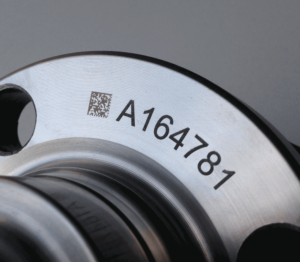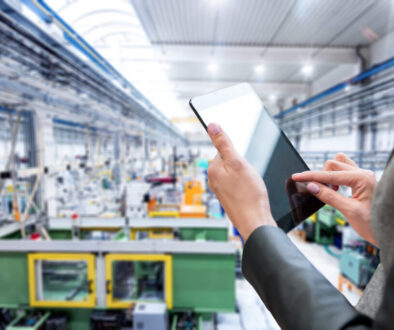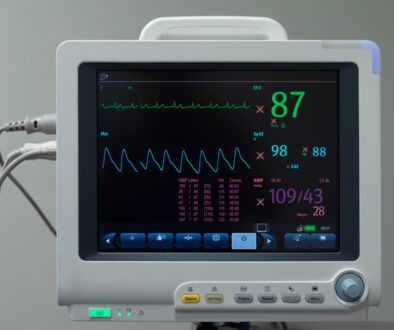7 Benefits of Fiber Laser Marking Machines

Is your production line bogged down by outdated direct part marking methods?
Imagine achieving clean, permanent markings on your parts with unmatched speed and precision — all while reducing maintenance headaches and boosting productivity. That’s the promise of fiber laser marking technology.
Fiber laser technology has become a pivotal tool across industries because of its precision, durability, and efficiency. Whether you’re marking intricate details on medical devices or ensuring traceability on industrial components, fiber lasers stand out for their adaptability and high performance.
Let’s explore the unique advantages of fiber laser marking machines, shedding light on why they’re increasingly chosen as the go-to solution for modern manufacturing challenges.
What is a Fiber Laser Marking Machine?
A fiber laser marking machine is an advanced industrial tool that uses a focused fiber laser beam to create permanent, high-precision marks on various materials. The laser alters the surface properties of the material, producing sharp, clear markings such as serial numbers, barcodes, logos, and other identifiers. This technology is highly valued for its precision, speed, and durability, offering consistent results with minimal maintenance.
Fiber laser marking machines are widely used across industries where permanent, high-quality markings are essential for traceability, branding, or compliance. Industrial laser marking applications include:
- Automotive: Marking parts for identification and traceability (VIN numbers, part numbers, logos).
- Aerospace: Marking components with serial numbers, part numbers, and other critical information for tracking and maintenance.
- Electronics: Marking circuit boards, components, and devices with serial numbers, logos, and other markings.
- Medical Devices: Marking instruments, implants, and other medical equipment with unique identification codes for traceability and regulatory compliance.
- Military: Marking weapons, equipment, and components for traceability, compliance, and inventory management.
7 Key Benefits of Choosing a Fiber Laser Marking Machine
Fiber laser marking changed industrial processes with its cutting-edge technology, delivering precision and efficiency like never before. This solution combines exceptional performance with a compact, versatile design, all while keeping maintenance and costs to a minimum.
These lasers have been a staple for decades, and here are seven reasons why:
- Precision and Beam Quality
- Energy Efficiency
- Versatility
- Compact Design
- High Output Power
- Reliability and Low Maintenance
- Cost-Effectiveness
1. Precision and Beam Quality
Fiber lasers offer exceptional precision, making them well-suited for intricate and detailed cutting applications. Their high beam quality allows for a finely focused spot, which results in sharp, clean edges with minimum material waste.
This level of accuracy is especially critical in industries such as aerospace and electronics, where precision is non-negotiable. With fiber lasers, manufacturers can achieve these results consistently, often eliminating the need for additional finishing work.
2. Energy Efficiency
Fiber lasers are known for their high energy efficiency, converting a significant portion of electrical power into laser light and minimizing energy waste. This efficiency translates to lower operating costs and a reduced environmental impact. Choosing this technology helps businesses save on energy expenses and promotes a more sustainable approach to manufacturing.
3. Versatility
Fiber lasers are exceptionally well-suited for direct part marking, offering unparalleled precision and versatility across a wide range of materials. From metals like steel and aluminum to non-metals such as plastics and wood, fiber lasers create detailed, durable marks that stand up to the demands of industrial and commercial applications.
4. Compact Design
Featuring a smaller footprint than many other laser types, fiber lasers are known for their space-efficient design. This compact form allows them to fit easily into existing setups, even in facilities with limited space.
This streamlined design optimizes space usage and simplifies workflow integration, enabling businesses to enhance productivity without needing extensive modifications. The result is a more efficient and adaptable operation that meets the demands of modern manufacturing environments.
5. High Output Power
Fiber lasers stand out in demanding applications that require intense, focused energy, thanks to their high output power. This capability ensures smooth, uninterrupted performance, even during continuous operation at elevated power levels.
Equipped with advanced heat dissipation systems, fiber lasers efficiently manage heat to prevent overheating and maintain stability during extended use. This reliability makes them ideal for applications where consistent, dependable output is critical.
6. Reliability and Low Maintenance
Two key advantages of fiber laser systems are their exceptional reliability and minimal maintenance needs. Their enclosed optical path protects the lasers from dust and debris, reducing the frequency of upkeep and ensuring consistent performance.
Fiber lasers maintain dependable operation even in challenging environments with extreme temperatures or vibrations. This robustness translates to smoother workflows, fewer interruptions, and greater peace of mind for businesses.
7. Cost-Effectiveness
Fiber lasers offer significant cost savings due to their exceptional energy efficiency and low maintenance requirements compared to traditional laser systems. Lower power consumption and minimal upkeep translate to reduced operational expenses. The solid-state design also minimizes the need for costly consumables and reduces repair frequency.
In high-volume production environments, this efficiency can accelerate return on investment (ROI) by lowering per-part processing costs and improving overall profitability, making fiber lasers a cost-effective long-term investment.
How Fiber Laser Marking Machines Compare with Other Lasers
Choosing the right laser for direct part marking is crucial for achieving high-quality results. While fiber lasers offer distinct advantages, it’s important to understand how they compare to other types. Let’s take a look at three different lasers and compare them:
- Vs. CO2
- Vs. Bulk
- Vs. Direct Diode
1. Vs. CO2
Fiber lasers excel at marking metals, providing the speed and precision necessary for creating sharp, durable marks. Their focused, high-intensity beam delivers consistent results, making them ideal for applications where accuracy and clarity are critical, such as serial numbers or barcodes.
CO2 lasers, by contrast, are better suited for non-metal materials like wood, plastics, or acrylic. While they are excellent for detailed designs on these surfaces, they lack the efficiency and precision required for high-quality metal part marking, giving fiber lasers the edge for industrial applications.
2. Vs. Bulk
Fiber lasers offer unmatched stability and beam quality, essential for consistent and precise direct part marking. Their fiber-optic design ensures a consistently focused beam over extended distances, maintaining accuracy and detail for intricate marking tasks.
Bulk lasers, however, are typically used in applications requiring short bursts of high peak power, such as specialized material processing. While they may be cost-effective in environments where fiber systems are impractical, they lack the precision and reliability of fiber lasers for direct part marking.
3. Vs. Direct Diode
Direct diode lasers are known for their speed and efficiency, particularly with reflective materials like copper or brass. However, they lack the beam quality of fiber lasers, making them less suited for fine, intricate markings that demand high contrast and sharp detail.
Fiber lasers combine exceptional beam quality with robust performance, delivering precise and permanent markings across a variety of materials. Their reliability and low maintenance requirements make them the preferred option for industries requiring consistent, high-quality direct part marking.
Frequently Asked Questions About Fiber Laser Marking Machines
1. What are the initial costs associated with implementing fiber laser technology, and how do they compare to other laser systems?
Fiber lasers typically have a higher upfront cost compared to other laser systems, such as CO2 or direct diode lasers. This is due to their advanced technology, higher energy efficiency, and durability. However, the lower operational costs—thanks to minimal maintenance, no consumables, and reduced energy consumption—make fiber lasers a cost-effective choice in the long run, especially for high-volume production environments.
2. Are there any material limitations or specific applications where fiber lasers are not the most effective choice?
Fiber lasers excel at marking metals and certain non-metals like plastics and composites. However, they are less effective for marking materials like wood, glass, or fabric, where CO2 lasers perform better. Fiber lasers might not be ideal for applications requiring extremely high peak power in short bursts, such as bulk laser applications in medical or specialized fields.
3. What are the typical maintenance requirements and operational costs for fiber laser systems over time?
Fiber lasers require minimal maintenance due to their solid-state design and enclosed optical path, which protects them from dust and debris. This design eliminates the need for consumables like gases or inks, significantly reducing operational costs. Over time, businesses benefit from lower repair frequency, consistent performance, and reduced downtime, making fiber lasers a reliable and cost-efficient option for long-term use.
Getting the Most from Fiber Laser Marking
Fiber laser marking machines are renowned for their precision, speed, and efficiency, making them an excellent choice across several applications. Their low-maintenance design and energy efficiency reduce downtime and help lower operational costs, providing a reliable and cost-effective solution for modern manufacturing.
To get the most out of your fiber laser, it’s essential to select a system tailored to your specific needs — considering factors like the materials you’ll be marking and the required production speed. With the right fiber laser, you can enhance productivity, achieve consistently high-quality results, and position your operation for long-term success.





